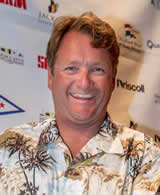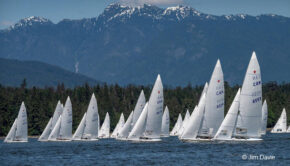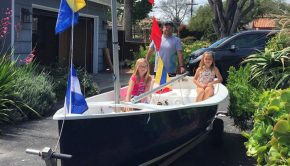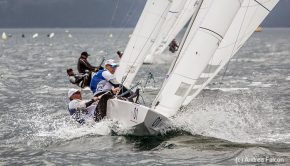Small Boat Sailing – Batteries Required
Published on November 5th, 2015
On a Friday evening each summer, a collection of characters can be found wiggling joysticks in anger, walking the docks as they compete in the weekly CR914 Model Yacht races at San Diego Yacht Club. With the race course alongside the food and beverage service, it is an event for both sailors and spectators.
 It is a casual atmosphere, filling that time slot between the end of the work week and the start of the weekend. But the fleet can get serious too, taking the fight nearby to the Mission Bay Model Boat Pond. This was the occasion when the class nationals were held on October 31-November 1 in San Diego, CA.
It is a casual atmosphere, filling that time slot between the end of the work week and the start of the weekend. But the fleet can get serious too, taking the fight nearby to the Mission Bay Model Boat Pond. This was the occasion when the class nationals were held on October 31-November 1 in San Diego, CA.
The field included reigning Lightning World Champion Geoff Becker, himself a 2-time class national champion, and Bill Hardesty, who won world titles this year in the Melges 20 and J/70. But it was George Szabo, better known for his exploits in the Snipe and Star classes, who took the title. Scuttlebutt editor Craig Leweck checked in with George for an update.
I hear you have some history in the class.
I’ve been sailing these for about eight years now. My wife bought me the boat for Christmas so I could enjoy the relaxed races that occur at the club during the summer. I did win the nationals once before when it was held at the Mission Bay pond in 2012.
To what degree is equipment controlled in the CR914 class?
The boat is like a Laser. All the equipment – sails, hulls, rigs, and all parts – come from one supplier/builder. The tolerances are pretty tight for building everything, and it is difficult to build your boat much better than the next guy. But like any one design fleet, there are small differences in rigging between all of the boats.
Sails are pre-made. No broadseam, only luff curve. A new suit (main and jib) is $50. It is good thing for me that we can’t build our own sails. I’m not sure I would get anything done at work if we could (note: George works for Quantum Sails).
Even with supplied equipment, preparation is king. Keeping the corrosion out of your wires, making sure all of the parts work, and are not going to break, etc. Maintenance on these things takes just as long racing. Even though the boat is small, just 3-feet long, the parts are that much smaller too, and that much more difficult to manipulate.
How well does your sit-down sailing skills translate to radio control sailing?
It is all the same. You need to properly tune and trim the outhaul, rake, sheet tension, vang, boat balance. Every size of boat has their idiosyncrasies that make them fast in each condition. This one is no different. You need to get it all right, so it is not uncommon to see boats come to shore for quick tweaks between races.
There are several styles out there as well. Some guys go more rake forward with fuller sails, while others are more rake aft with flatter sails. Each does better in its condition. Tactics are similar too. Avoid collisions, and have good fleet balance.
The last day of the Nationals this year, I needed to make up 7 points to get into first. So, getting perfect starts, hitting shifts, and covering the leader were crucial. Also difficult was that with 18 races in a weekend, every time you got further ahead on points, another throw-out would kick in and the game was close again. Going into the last race I was only one point ahead, so standard regatta tactics still applied. Nothing different there.
In some ways the sailing is more difficult as well. You can’t always see everything. Sometimes other boats are in your way, and you just can’t see your boat. Mark rounding’s tend to be mess and finding windshifts can be a bit trickier as well. The puff you feel on your neck is not the same wind your boat is sailing in. And, being so close to the water, the shifts are different than out in open water.
Any tips on depth perception? Being able to judge distance when rounding marks or maneuvering around boats can’t be easy.
Depth perception is definitely one if the biggest issues across the fleet. At marks, you need to watch the shadow of the sails on the mark, look for the wake of the boat to see where it is compared to the mark, or you can run into it as well (allowed in model boat rules). One nice way to get the leeward mark close is to tap it with your jib or main boom and then turn. It’s not the best tactical rounding – come in tight and out wide – but it beats going four lengths past the mark before you turn. Crossing situations can be even more exciting.
For someone that has never raced RC events, what would be your short list of tips to prepare them?
Just like any other boat, practice, practice, practice. Read up on all of the tuning articles, ask questions, and take notes. Build your own tuning grid, and go have fun.









 We’ll keep your information safe.
We’ll keep your information safe.